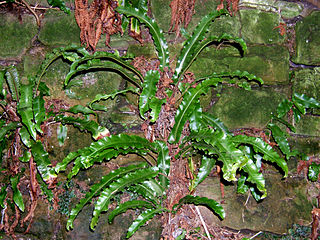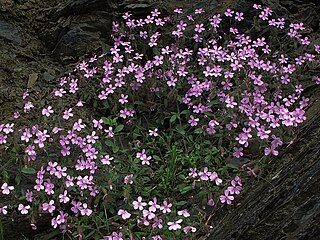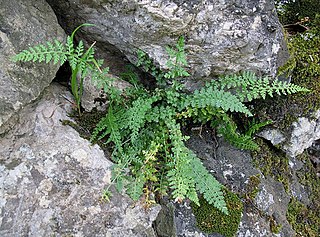
Asplenium is a genus of about 700 species of ferns, often treated as the only genus in the family Aspleniaceae, though other authors consider Hymenasplenium separate, based on molecular phylogenetic analysis of DNA sequences, a different chromosome count, and structural differences in the rhizomes. The type species for the genus is Asplenium marinum.

Asplenium scolopendrium, commonly known as the hart's-tongue fern, is an evergreen fern in the genus Asplenium native to the Northern Hemisphere.

The Bonin flying fox, Bonin fruit bat, or in Japanese Ogasawara giant bat is a species of flying fox in the family Pteropodidae. It is endemic to four islands in Ogasawara Islands, Japan. Its natural habitat is subtropical forests. It is threatened by habitat loss.
Asplenium aequibasis is a species of fern in the family Aspleniaceae. It is found in Tristan da Cunha. Its natural habitat is subantarctic shrubland.
Asplenium ascensionis is a species of fern in the family Aspleniaceae. It is endemic to Ascension Island. Its natural habitats are receding due to introduced vegetation. It is threatened by habitat loss.

Hymenasplenium cardiophyllum is a species of fern in the family Aspleniaceae. It is native to China and Japan. Its natural habitat is subtropical or tropical moist lowland forests. It is threatened by habitat loss.
Asplenium congestum is a species of fern in the family Aspleniaceae. It is endemic to Ecuador. Its natural habitats are subtropical or tropical moist lowland forests and subtropical or tropical moist montane forests. It is threatened by habitat loss for agriculture.
Asplenium ecuadorense is a species of fern in the family Aspleniaceae. It is endemic to Ecuador. Its natural habitats are subtropical or tropical moist lowland forests and subtropical or tropical moist montane forests. It is threatened by habitat loss.
Asplenium schweinfurthii is a species of fern in the family Aspleniaceae. It is endemic to Yemen. Its natural habitats are subtropical or tropical dry forests and subtropical or tropical dry shrubland. It is threatened by habitat loss.
Asplenium virens is a species of fern in the family Aspleniaceae. It is endemic to Ecuador, where it is found in coastal forests. This habitat is fragmented and degraded, and habitat loss is the main threat to the species.

Urera kaalae, opuhe, is a species of flowering plant in the nettle family, Urticaceae, that is endemic to the island of Oʻahu in Hawaii. It inhabits slopes and gulches in mesic forests at elevations of 300–760 m (980–2,490 ft). Currently it is restricted to the southern and central parts of the Waiʻanae Mountains. Associated plants include maile, hame, Asplenium kaulfusii, Athyrium spp., ʻāwikiwiki, pāpala, ʻakoko, poʻolā, ēlama, Doryopteris spp., ʻieʻi.e., manono, Hibiscus spp., olopua, māmaki, hala pepe, ʻālaʻa, kōpiko, heuhiuhi, aʻiaʻi, ōpuhe, and maua. It is threatened by habitat loss.
Cyanea procera is a rare species of flowering plant in the bellflower family known by the common name Molokai cyanea. It is endemic to Hawaii, where it is known only from the island of Molokaʻi. It is a federally listed endangered species of the United States. Like other Cyanea it is known as haha in Hawaiian.
Asplenium daghestanicum, the Dagestanian spleenwort, is a species of spleenwort that is endemic to Dagestan in Russia. It is known only from Agulsky and Khivsky districts. It can be found on shaded schist rocks in the middle montane zone, at elevations from 1,800 to 2,300 m. Its population is estimated to be 1,500–2,000 mature individuals. It is threatened by the effects of climate change on its microhabitat.
Asplenium hermannii-christii, Hermann Christ's asplenium, is a species of spleenwort that is endemic to Georgia. It is known from only one location, in the Bzyb River gorge in Abkhazia. It can be found on calcareous rock crevices in the lower montane zone, from elevations of 150–170 m. It is threatened by recreational activities. This species is named after fern botanist Konrad H. Christ.

Asplenium schizotrichum is a species of spleenwort that is endemic to the island of Rarotonga in the Cook Islands. Its population is estimated to be less than 20 mature individuals.

Turbinaria bifrons, commonly known as disc coral, is a species of colonial stony coral in the family Dendrophylliidae. It is native to the Indo-Pacific region. It is a zooxanthellate coral that houses symbiont dinoflagellates in its tissues. This is an uncommon species and the International Union for Conservation of Nature has rated its conservation status as being "vulnerable".

Petrocoptis pseudoviscosa, commonly known as falguera, is a species of plant in the family Caryophyllaceae. It is endemic to the Spanish province of Huesca, where it is only known from the Valle del Ésera in the Pyrenees. Its natural habitat is calcareous cliffs, crags and caves.

Asplenium fontanum, commonly known as fountain spleenwort or smooth rock spleenwort, is a species of fern in the family Aspleniaceae, native to rocky areas in Western Europe.
Asplenium haughtonii, also known as the Barn fern, is a species of fern in the family Aspleniaceae. It is native to Saint Helena.
Asplenium dielfalcatum is a species of fern in the family Aspleniaceae. It is native to Oahu, Hawaii.









